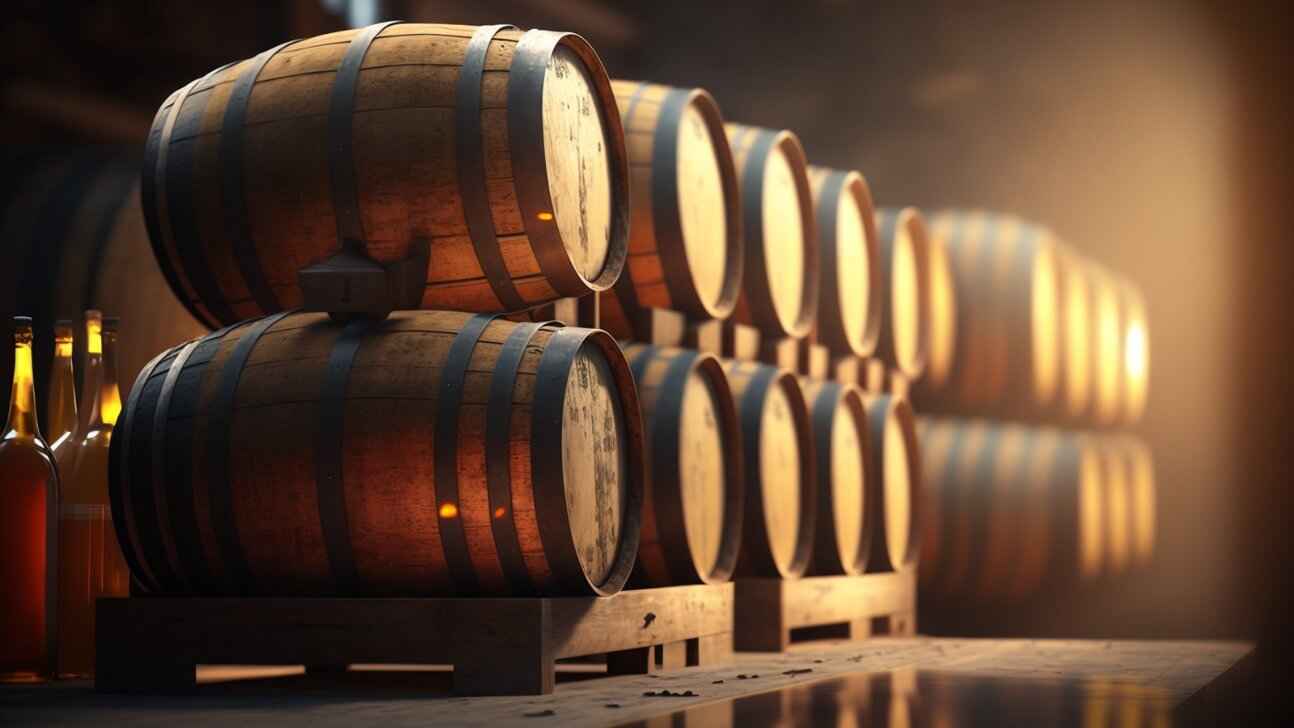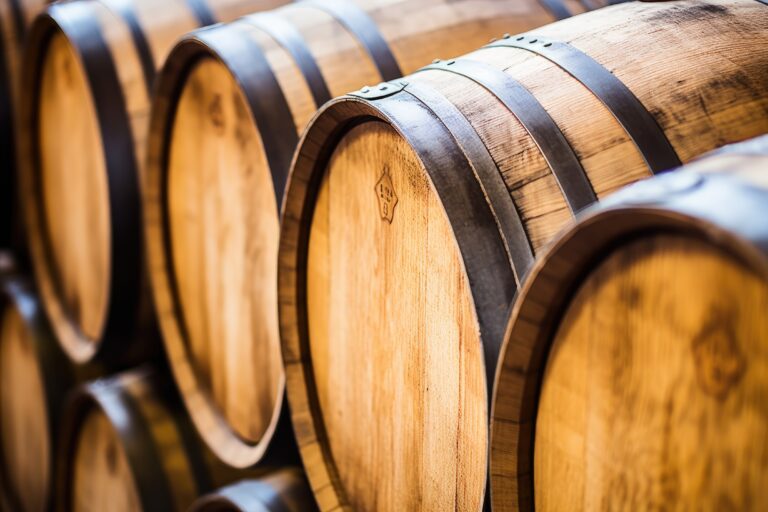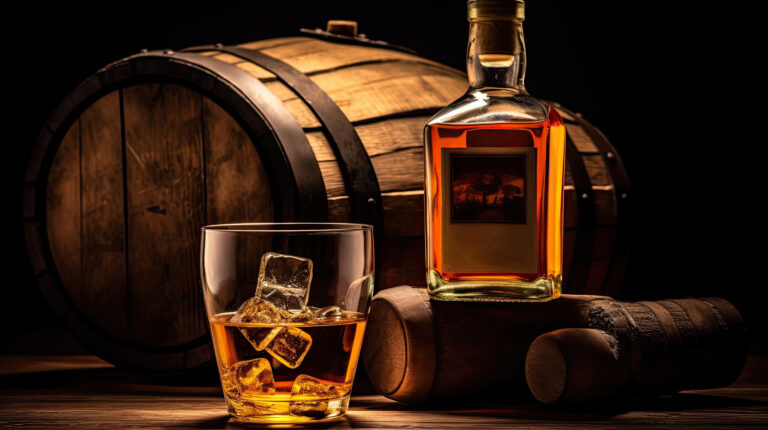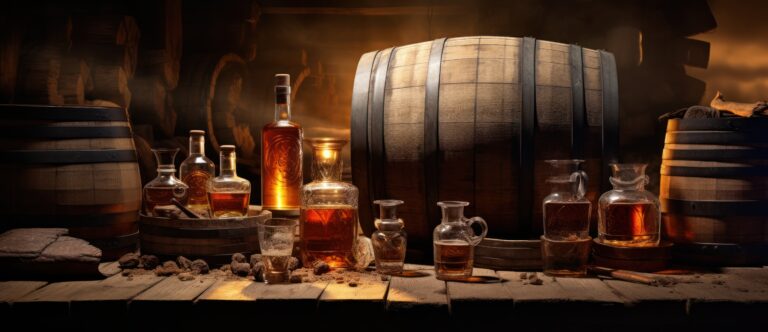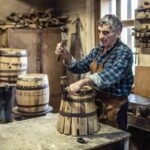So you’ve heard about whiskey barrels but you’re not really sure what they are or why they’re important. Not to worry, we’ve got you covered. Whiskey barrels are charred oak casks used to age and flavor whiskey. The barrels impart distinctive aromas and tastes to the whiskey during the aging process. Without barrels, whiskey would be colorless and harsh. Barrels transform the spirit into the complex, amber-colored whiskey we all know and love. Pretty cool, right? In this guide, we’ll walk you through everything you need to know about whiskey barrels, from how they’re made to how they influence the flavor and color of your favorite whiskey. By the end, you’ll be a whiskey barrel expert and ready to impress your friends. So grab your favorite whiskey and let’s dive in!
What Is a Whiskey Barrel?
A whiskey barrel is a charred oak barrel used to age and flavor whiskey. Distillers fill the barrels with clear distilled spirits and then store them in warehouses for years.
As the whiskey sits, it absorbs flavor and color from the wood. The char inside the barrel also helps filter and mellow the whiskey. Many distillers use barrels that previously aged bourbon or sherry, adding another layer of flavor.
- Barrel aging improves whiskey through oxidation, evaporation, and imparting wood flavors.
- The whiskey absorbs compounds like lactones, vanillins, and tannins from the wood.
- Evaporation concentrates the whiskey’s flavor and is known as the “angel’s share”.
- Barrel aging also mellows the whiskey by smoothing out harsh edges and bitterness from the distillation process.
The specifics of the barrel like the type of wood, level of char, and previous use impact how the whiskey ages and develops character. Barrel aging is a complex interaction between wood and spirit that produces the distinctive flavor of aged whiskeys.
So now you know – a whiskey barrel is the vessel where distilled spirits transform into aged whiskey. The barrel gives whiskey color, filters and mellows the spirit, and, most importantly, infuses it with flavor that creates distinctive and memorable taste experiences.
The History of Whiskey Barrels
Whiskey barrels have been used for centuries to age and flavor spirits. Dating back to the 15th century, barrels were employed to transport goods and store items like wine, beer, and whiskey during long sea voyages.
As time went on, distillers noticed that the oak barrels imparted flavor and aroma compounds to the spirits. The porous wood allows oxygen in, mellowing the whiskey. The charred interior provides smoky notes. The wood’s natural compounds like vanillin and lactone add hints of vanilla, caramel, and coconut.
By the 1700s, aging whiskey in charred oak barrels became common practice. Different barrel types like American white oak and European red oak produce distinctive flavors. The barrels are usually used bourbon casks, imparting hints of vanilla and spice.
Today, most distillers use pre-used bourbon barrels. The first use creates mellow, oaky notes, while subsequent uses produce more complex flavors. Maturing whiskeys in barrels for longer periods results in a smoother, richer spirit.
The humble whiskey barrel, once a simple storage device, is now essential for crafting a premium spirit. Its time-honored tradition and irreplaceable role in creating flavor make the barrel an icon of whiskey-making history.
How Whiskey Barrels Are Made
How Whiskey Barrels Are Made
Whiskey barrels are made from oak, typically American white oak or European oak. The wood is cut into staves that are shaped into a barrel.
- The staves are heated to make them pliable, then bent and fitted together with metal hoops before the barrel is toasted. Toasting the barrel involves heating it to bring out the natural flavors of the wood. The level of toasting, from light to heavy, determines how much flavor the wood will impart to the whiskey.
- After toasting, the barrels are charred on the inside. The charring process involves burning the interior of the barrel, which creates a layer of carbon. The char helps filter the whiskey and gives it a smokey flavor. The level of char, from light to heavy, determines how much smokey flavor will be imparted.
- Once assembled and toasted, the barrels are ready to be filled with whiskey. As the whiskey ages in the barrels, the wood expands and contracts with temperature changes. This allows the whiskey to seep deep into the wood, absorbing the wood’s flavors and aromas. The longer the aging process, the more complex the flavors become.
- Most whiskey barrels are only used once. Bourbon whiskey barrels cannot be reused. After aging, the barrels are discarded or recycled for decorative purposes. Some are repurposed as furniture, planters or other objects. A few distilleries reuse barrels for aging other spirits like rum, brandy or scotch. But for the finest whiskeys, new charred oak barrels are always used.
Types of Wood Used for Whiskey Barrels
Types of Wood Used for Whiskey Barrels
The wood used to make whiskey barrels impacts the flavor and aroma of the aged spirit. The most common types of wood are oak, maple and hickory.
Oak is the wood of choice for most whiskey makers. Its tight grain and ability to impart flavors like vanilla, caramel and spice make it ideal. The two most popular oak varieties are American white oak and European oak. White oak, like that grown in America, tends to produce bourbon and other whiskeys with sweet, smooth flavors. European oak, used for Scotch whisky, provides more robust, smoky notes.
Maple wood barrels, usually made from sugar maple, create a lighter, sweeter flavor profile with hints of maple syrup. Whiskeys aged in maple pick up notes of brown sugar, nuts and fruit. Maple barrel aging is an innovative process used by some craft distilleries.
Hickory wood is sometimes used for finishing or “finishing” barrels. It produces a distinctive smoky, savory and bacon-like flavor. The strong, robust qualities of hickory wood are best used sparingly, often just for a few months at the end of the aging process.
In the end, the type of wood, and where it’s from, has a significant impact on the flavor of aged whiskey. Master distillers thoughtfully select and blend barrels to create the unique taste profile of their spirits.
The Aging Process Inside a Whiskey Barrel
The aging process is what gives whiskey its distinctive flavor and aroma. Once the distillation process is complete, the clear distillate is aged in charred oak barrels. Over time, the whiskey absorbs flavors and colors from the wood.
The Barrel
The type of barrel used – typically oak – and how they’re charred impact the flavor. American oak barrels with a heavy char are common for bourbon. For Scotch, used barrels that previously aged bourbon or sherry are often used.
Evaporation
As the whiskey ages, some of the liquid evaporates – this is known as the “angel’s share”. The evaporation concentrates the flavors and aromas, intensifying the whiskey’s character. The angel’s share can be up to 2% of the barrel’s volume each year.
Flavor Compounds
Compounds from the wood like vanillin and lactone add sweet, vanilla notes. Charring the barrel releases other compounds that impart smoky, spicy flavors. As the whiskey ages, these flavors become more pronounced. Additional flavors develop due to oxidation and other chemical reactions between the whiskey and wood.
Color
Whiskey gets its amber hue from compounds like tannins extracted from the oak barrel. As it ages, the color deepens to shades of gold and brown. The color is a visual cue as to how long it was aged.
The aging process requires patience, but is integral to developing the distinctive character of fine whiskeys. The longer a whiskey ages, the more complex its flavors and aromas become. Most premium whiskeys are aged at least 12 years, while some ultra-premium brands age for 18 years or more.
How a Barrel Impacts Flavor and Color
The barrel is essential to developing the flavor and color of whiskey. As the spirit ages, it absorbs compounds from the wood that impart distinctive aromas and tastes.
Char Level
The level of char or toast on the inside of the barrel impacts how much flavor is imparted. A lighter toast provides subtler wood notes, while a heavier char introduces smoky, toasted elements. Bourbon, for example, requires the use of new, charred oak barrels to achieve its distinctive vanilla and caramel profile.
Wood Type
The type of wood used, typically oak, also affects the whiskey. American oak barrels yield sweeter, vanilla flavors, while French oak provides spicier notes of clove and nutmeg. Used barrels, which have already aged another spirit like sherry or port, introduce another layer of aromas to the whiskey.
Climate
The climate where the barrel is stored causes it to expand and contract, allowing the whiskey to seep in and out of the wood. In warmer areas, the interaction happens faster, resulting in a more rapid aging process. Colder climates produce slower, more subtle effects. This is why whiskeys from Scotland and Ireland tend to be lighter in color and flavor than those from Kentucky or Tennessee.
Time
The longer a whiskey ages, the more complex its flavor and color becomes. Over years and decades, it develops rich amber hues, fruity esters, and mellow, rounded flavors as harsher compounds break down. This is why older whiskeys are more rare and expensive. But aging also results in evaporation, so less whiskey is left in the barrel. It’s a delicate balance between gaining flavor and losing volume.
Reusing Whiskey Barrels for Other Spirits
Once whiskey has been aged in barrels, the barrels themselves still have plenty of flavor left to impart. Many distillers will reuse barrels for aging other spirits to enhance their flavor profiles.
Brandy
Cognac and armagnac are often aged in used whiskey barrels, especially those that previously held bourbon. The barrel’s charred interior and lingering whiskey flavors blend with the brandy, resulting in notes of vanilla, spice and dried fruit.
Rum
Dark rum styles like navy rum are commonly aged in used whiskey casks. The barrel aging gives rum sweet hints of toffee, cocoa and toasted oak along with a amber color. For spiced rum, the additional flavors of cinnamon, clove and nutmeg pair nicely with the whiskey barrel influence.
Port and Sherry
Fortified wines port and sherry are sometimes finished or aged in used whiskey barrels. The barrels impart flavor notes of nuts, chocolate and smoke that blend with the wines’ fruity and savory characteristics. Whiskey barrel aging helps create richness and body in these fortified wines.
Beer
Certain beer styles like stouts, porters, barleywines and old ales are often aged in used spirit barrels, including whiskey barrels. The barrels infuse the beer with oak aroma and taste as well as flavors from the previous whiskey like vanilla, caramel and dried fruit. Barrel aging also helps the beer develop more complexity over time.
As you can see, whiskey barrels have a second life aging and flavoring many other wonderful spirits and wines. Their charred oak interiors and lingering whiskey essences create layers of flavor that blend and age with each new spirit. It’s a perfect example of reuse and sustainability in the spirits world.
Fun Facts About Whiskey Barrels
Fun Facts About Whiskey Barrels
Did you know whiskey barrels have a fascinating history? Here are some interesting facts about these iconic containers:
- Whiskey barrels were originally used to transport goods, not age whiskey. Distillers discovered that the wood barrels imparted desirable flavors and aromas to the spirit during shipping.
- The most common woods used are American white oak and European oak. American white oak is commonly used for bourbon, as it imparts a sweet, vanilla flavor. European oak tends to impart more spice and fruit notes.
- A barrel can only be used a few times to age whiskey. After a few uses, there are fewer flavor compounds left to impart to the spirit. Used barrels are often sold to age other spirits like rum, brandy or wine.
- Barrels breathe as the wood expands and contracts. This allows for oxidation and evaporation, which concentrates the flavor of the whiskey. Up to 50-70% of a barrel’s contents can evaporate over time.
- The size and shape of barrels affects how quickly whiskey ages. Smaller barrels age whiskey faster due to increased surface area. The barrel’s shape also impacts how much of the whiskey comes into contact with the wood.
- Barrels are rarely completely full and are never completely empty. As the “angel’s share” evaporates, the empty space left in the barrel allows for oxidation. When the barrel is nearly empty, it is retired.
- Whiskey stops aging once bottled, so barrel aging is a crucial step. Master distillers determine when the whiskey has achieved the perfect balance of flavors before bottling.
Those are some illuminating details about the vessels instrumental in creating one of the world’s most prized spirits. Whiskey barrels have a history as rich and complex as the amber liquid they hold.
Whiskey Barrel FAQs: Your Top Questions Answered
Whiskey Barrel FAQs: Your Top Questions Answered
What are whiskey barrels made of?
Whiskey barrels are typically made of oak, often American white oak or European oak. Oak wood is ideal for aging whiskey because it’s porous enough to allow the whiskey to breathe, while also imparting flavor to the whiskey from the wood.
How long are whiskey barrels used?
Whiskey barrels are usually used for 3 to 6 years before being retired. As barrels are used, they lose their ability to impart flavor and aroma to the whiskey. After a few years, most of the desirable compounds in the wood have been transferred to the whiskey. At this point, the barrels are usually sold to age other liquors like rum, brandy or wine. Some whiskey brands will use barrels up to 10-15 years, but this is less common.
What happens inside a whiskey barrel?
Inside a whiskey barrel, several chemical reactions take place that give aged whiskey its distinctive flavor, aroma and color:
- Oxidation: The whiskey is exposed to small amounts of oxygen through the porous wood, which mellows the flavor.
- Evaporation: About 2% of the whiskey evaporates each year, which is known as the “angel’s share.” This concentrates the flavor and aroma compounds.
- Extraction: Flavorful and aromatic compounds from the oak wood are extracted into the whiskey, like vanilla, cinnamon and clove notes.
- Polymerization: Over time, the complex organic molecules in the whiskey link up and form longer chain polymers, which alters the flavor and gives aged whiskey a smooth, silky mouthfeel.
Why are whiskey barrels charred?
Whiskey barrels are charred on the inside before being filled to impart smoky flavors to the whiskey. The char layer also acts as a filter, trapping certain undesirable compounds from entering the whiskey. The level of char depends on the specific whiskey brand and style. A lighter char will produce subtler smoky notes, while a heavier char leads to a more robust smoky flavor in the whiskey.
Final Thoughts
And there you have it, everything you need to know to get started with whiskey barrels. Now you can impress your friends at the bar by casually dropping some barrel knowledge. More importantly, you have a solid foundation to start exploring the wonderful world of aged whiskey. Who knows, you may find a new favorite dram that becomes your go-to. The variations are endless. So grab a glass, pour a few fingers of your preferred whiskey, and savor the flavors imparted by the wood. The barrel’s influence is truly an art form. Here’s to discovering the magic of the barrel, one sip at a time. Cheers!
